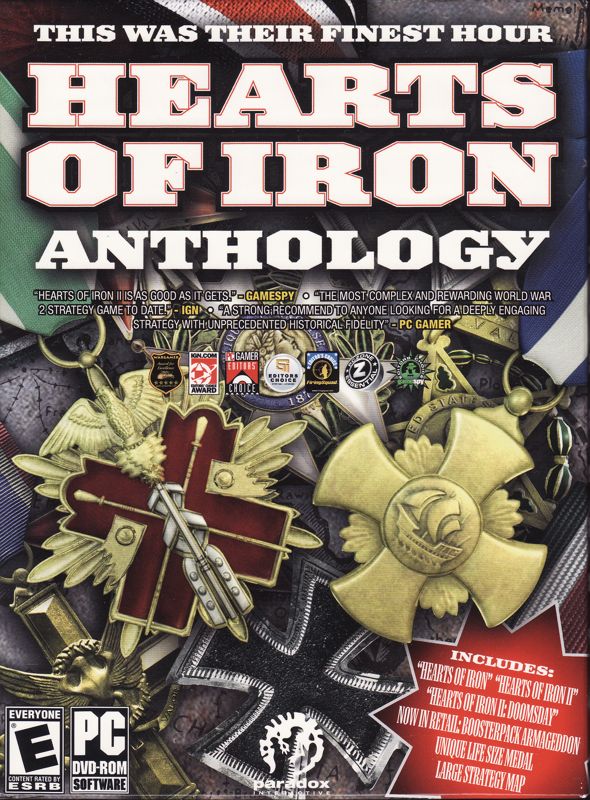Retro Replay Review
Gameplay
The Hearts of Iron: Anthology offers a deep and intricate grand strategy experience that spans the entire World War II timeline and beyond. Each installment—Hearts of Iron, Hearts of Iron II, Hearts of Iron II: Doomsday, and Hearts of Iron II: Doomsday – Armageddon—builds on the core mechanics of diplomacy, research, production, and warfare. You begin by choosing any nation on the world map and guiding it through economic planning, military mobilization, and alliance management. The sheer scope allows you to play as a major power or a minor state looking to reshape the geopolitical landscape.
(HEY YOU!! We hope you enjoy! We try not to run ads. So basically, this is a very expensive hobby running this site. Please consider joining us for updates, forums, and more. Network w/ us to make some cash or friends while retro gaming, and you can win some free retro games for posting. Okay, carry on 👍)
One of the standout features is the way the series encourages player-driven narratives. There are scripted historical events, but the AI can deviate significantly based on your actions and the actions of other powers. This dynamic system ensures high replayability: you can attempt a German victory over the Soviets, lead the United States down an isolationist path, or even see a communist bloc rise in Latin America. The Doomsday expansions further enrich the experience by introducing hypothetical Cold War scenarios, letting you influence nuclear brinkmanship or a renewed global conflict in the 1950s.
Conflict resolution in Hearts of Iron leans heavily on planning and logistics rather than just numbers on a map. You must allocate resources, oversee supply lines, and coordinate land, sea, and air operations. Naval invasions, strategic bombing campaigns, and partisan uprisings all require careful timing and coordination. The Anthology includes a strategic world-map poster that not only serves as an immersive visual aid but also helps you plot your long-term campaigns away from the screen.
Graphics
By modern standards, the graphics across the Hearts of Iron series are functional rather than flashy. The original Hearts of Iron launched in 2002 with a 2D map and basic unit icons, and while it feels dated today, it retains a certain clarity that veterans appreciate. Hearts of Iron II refined the interface, offering better resolution support, clearer front-line indicators, and more detailed province maps. These changes streamline management tasks and reduce UI clutter, which becomes essential when juggling dozens of theaters of war.
The Doomsday and Armageddon expansions make subtle visual tweaks to represent nuclear fallout, shifting front lines, and new unit models for post-WWII equipment. The result is a consistent visual language across all titles that never distracts from the strategic depth. Color-coded borders and terrain overlays emphasize chokepoints and resource-rich regions, giving players immediate feedback on where to focus research or reinforce defenses.
As part of the Anthology, the inclusion of a high-quality, fold-out strategic world-map poster is a nice tactile complement to the on-screen graphics. It replicates the digital map’s detail and allows for off-screen planning sessions, whether you’re annotating potential sweeps through Eastern Europe or sketching naval blockade routes in the Pacific. For fans who appreciate analog strategy alongside digital gameplay, this physical element adds genuine value to the package.
Story
Hearts of Iron is less about a fixed narrative and more about emergent storytelling generated by your strategic decisions and the AI’s responses. There is no linear “campaign” in the traditional sense; instead, the story unfolds as you choose a nation, set national focuses, and respond to world events. This sandbox approach means every playthrough feels unique: you might live out an alternate history where Japan conquers Australia or watch NATO and the Warsaw Pact lock horns in a nuclear standoff during the Doomsday era.
The anthology’s built-in event system presents historical milestones—such as Operation Barbarossa or D-Day—while allowing for ideological divergence. The Doomsday expansions inject hypothetical Cold War tensions, spawning scenarios where you negotiate with the United Nations over nuclear nonproliferation or execute surprise missile strikes. These what-if possibilities fuel countless “what happens next?” moments, turning a static timeline into a living, breathing world.
While there is no character-driven plot, the human element emerges through ministerial advisors, generals, and political leaders whose traits impact research speed, army morale, or technological breakthroughs. If you lose a high-ranking field marshal or purge dissenting ministers, you’ll feel the ripple effects in production throughput or diplomatic leverage. This layered storytelling—woven through numbers, modifiers, and event scripts—delivers a compelling narrative tapestry driven by player choice.
Overall Experience
Hearts of Iron: Anthology represents exceptional value for any grand strategy enthusiast or history buff. The compilation deftly combines four major titles with their expansions into one cohesive package. Whether you’re new to the series or a veteran returning to fine-tune nuclear strategies in Doomsday – Armageddon, the Anthology ensures you have access to every feature and improvement released over the past two decades.
The physical extras—a unique medal and a large strategic poster—underscore Paradox’s dedication to fan engagement. They serve as both collectibles and practical planning tools, enriching the tactile experience beyond the screen. Combined with a robust modding community and Steam Workshop support, this anthology invites endless customization, from overhauling unit graphics to adding new scenarios that challenge historical orthodoxies.
With its blend of historical authenticity, sandbox flexibility, and potent strategic depth, Hearts of Iron: Anthology is a must-have for those who crave grand-scale conflict simulation. It rewards patience, critical thinking, and long-term planning, offering a sandbox where world history is yours to rewrite—even if your first victory ends in a nuclear winter. For buyers seeking a deep, replayable strategy package with tangible collector’s items, this anthology checks all the boxes.
 Retro Replay Retro Replay gaming reviews, news, emulation, geek stuff and more!
Retro Replay Retro Replay gaming reviews, news, emulation, geek stuff and more!




Reviews
There are no reviews yet.